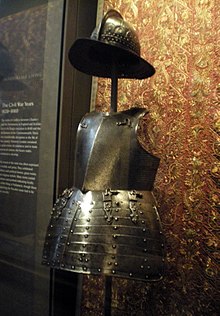
A corslet or corselet is defined by the Oxford English Dictionary as "a piece of defensive armour covering the body" and is first attested around 1500.
Such pieces of armour have existed in various forms under various names throughout much of history, designed to protect the vital organs, arteries and nerves in the abdomen, chest and back.
In ancient Egypt, Ramesses II is said to have worn a similar device during battles. In Ancient Greek armies, the "hoplites", or heavy infantrymen, wore similar bronze armour known as a thorax, as well as a linen version known as a linothorax to protect their upper bodies.
By the 16th century, the corslet, also spelled corselet, became popular as a light-half-armour for general military use, e.g., by town guards. It consisted of two plates connected on the sides via hinges and pins that could include a gorget and tassets, and combined with full arms and gauntlets.
The word "corslet" was adopted as a so-called "occupational surname," later altered to Coslett, Cosslett, Coslet, etc., following the arrival of an expert in the manufacture of osmond iron, Corslet Tinkhaus, to Wales from his native Westphalia in 1567.
According to Webster's Third New International Dictionary, corslet also refers to a soldier equipped with a corslet.
References









You must be logged in to post a comment.